Discovery
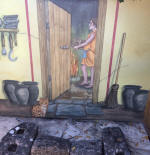 Bucknowle Roman villa was discovered by
accident in 1975 when amateur archaeologist Tony Brown was out
walking. He noticed that many of the molehills contained Roman
pottery and more significantly, pieces of red roof tile. He was
given permission from the landowner to dig a small trial trench,
and the rest as they say is history.
Bucknowle Roman villa was discovered by
accident in 1975 when amateur archaeologist Tony Brown was out
walking. He noticed that many of the molehills contained Roman
pottery and more significantly, pieces of red roof tile. He was
given permission from the landowner to dig a small trial trench,
and the rest as they say is history.
The Excavations
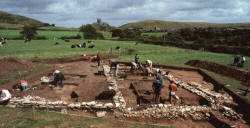 Between 1976 and 1991 a dedicated group of
volunteers returned for several weeks each summer and their
endeavours culminated in the uncovering of not only a Roman villa
but evidence for occupation stretching back at least 7000 years.
Between 1976 and 1991 a dedicated group of
volunteers returned for several weeks each summer and their
endeavours culminated in the uncovering of not only a Roman villa
but evidence for occupation stretching back at least 7000 years.
The First Occupants
Bands of hunter-gatherers roamed the area
around 5000 BC leaving evidence in the form of stake holes perhaps
from a temporary shelter and by scatters of flint tools. At this
time the landscape was wooded with oak, elm and lime and alder in
the wetter places.
By about 3000 BC in a clearing in the woodland
a ‘henge’ type feature was constructed overlooking the Corfe
River. This consisted of double ditches approximately 16m and 25m
in diameter. Occupation evidence is in the form of pottery and
flint tools and intriguingly part of a stone hand axe of Cornish
origin. The area was used for meetings and gatherings and probably
feasting.
The first farmers had comprehensively cleared
the woodland by about 1700 BC and two or three thousand years
later a round ‘barrow’ again overlooking the river, became the
focus of small burial ground where at least two individuals were
cremated then buried in pots.
Over the next millennia farming was the chief
activity on the site but the Bronze Age barrow was respected by
the first roundhouses on the site and an area dedicated to the
digging of pits where domestic rubbish was carefully disposed of
and then capped with a mound of earth.
In the century before the Roman conquest a
burial of a crouched female accompanied by complete pots was
inserted into the mound. Four large roundhouses stood nearby. From
then up until the conquest itself in AD 43, continental imports of
pottery and amphora (which had been full of wine) are evidence not
only of a reasonable lifestyle but also access to luxury goods
which came on to the site through trade.
The Roman Villa
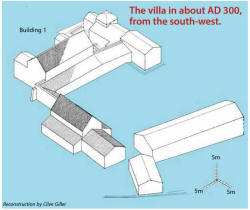 The site chosen by the first occupants of the
villa could not have been bettered. The buildings were constructed
on a slight plateau above the River Corfe and the complex grew
from two buildings in the first instance to 17 separate
structures. Not all buildings were standing at the same time but
over 400 years the site changed and developed with contemporary
technology and fashion. Local material of limestone and chalk were
used in all phases of its construction.
The site chosen by the first occupants of the
villa could not have been bettered. The buildings were constructed
on a slight plateau above the River Corfe and the complex grew
from two buildings in the first instance to 17 separate
structures. Not all buildings were standing at the same time but
over 400 years the site changed and developed with contemporary
technology and fashion. Local material of limestone and chalk were
used in all phases of its construction.
Early Roman (Late 1st-
mid-2nd century AD)
Two buildings marked the first phase of the
villa. These consisted of a large ‘aisled hall’ and a possible
bathhouse.
Middle Roman (Mid-2nd
– mid 3rd century AD)
The aisled hall continued in use but new
bathhouse was built together with a small block which contained
underfloor heating. A little distance away six flimsier,
timber-framed buildings most likely associated with workshops,
stores or farm buildings.
Later Roman (2nd half
of the 3rtd century AD)
A number of the workshops and farm buildings
were rebuilt and enlarged. In addition, a completely new domestic
block of three rooms fronted by a corridor was built and
eventually became the largest building on the site. One of the
rooms had a red tessellated floor made from chopped up roof and
box flue tiles and another was floored with large Purbeck
limestone slabs.
Latest Roman (4th
century)
The site was completely re-vamped by further
rebuilding and alterations culminating in the presence of three
large buildings plus a bath house arranged around a courtyard. The
workshops further to the south went out of use at this time and
were replaced by a large building which was completely separate
from the other two ranges. This faced the large corridor-fronted
block which was extended and heightened by another storey. On the
ground floor there were 10 rooms including one with a heated floor
and at least two mosaic pavements. This building was the main
domestic range. On one side the building was connected to a
refurbished bath house by a covered portico and another portico
linked up with the aisled hall. Here, newly tessellated floors
decorated three of the rooms and the building’s function may have
been as an administrative centre.
The Door stones
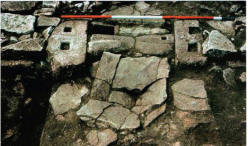 The main entrance to the living quarters
appeared to be at the ‘back’ of the building where it faced
north-west. This gave entry to the limestone paved room and
immediately left was another doorway into a slightly smaller room.
Opposite this was a third doorway, the most elaborate and best
preserved on the site. It consisted of four limestone blocks and
associated paving slabs from the floors of both rooms. The larger
rectangular stones contain pairs of sockets which once held
upright timbers for door frames on either side of an internal
wall. The doorstep threshold was made up of two stones set at
right angles to the door frame stones; one of these has a small
square hole for a wooden peg doorstop. Arcing grooves in the
doorstep fossilise the wear and tear of the door (which was about
0.9m wide) opening and closing.
The main entrance to the living quarters
appeared to be at the ‘back’ of the building where it faced
north-west. This gave entry to the limestone paved room and
immediately left was another doorway into a slightly smaller room.
Opposite this was a third doorway, the most elaborate and best
preserved on the site. It consisted of four limestone blocks and
associated paving slabs from the floors of both rooms. The larger
rectangular stones contain pairs of sockets which once held
upright timbers for door frames on either side of an internal
wall. The doorstep threshold was made up of two stones set at
right angles to the door frame stones; one of these has a small
square hole for a wooden peg doorstop. Arcing grooves in the
doorstep fossilise the wear and tear of the door (which was about
0.9m wide) opening and closing.
Life in the villa
Large numbers of finds illustrate the
lifestyle of those people living at Bucknowle from the elite
(that’s probably how they saw themselves) to the lower orders of
workers.
The large number of coins found (213) indicate that a
monetary economy was important and that many of the items found on
the site were purchased with coinage.
Enormous quantities of pottery were recorded;
this was dominated by ‘Black Burnished Wares’ which were locally
made in the Wareham area at Bestwall, Redcliffe and Worgret. These
sturdy kitchenwares were the pots of choice for cooking, storing
and even serving foodstuffs. However, the inhabitants also
acquired expensive imported pottery from France, Germany and from
other regions of England. Wine came from Italy and Spain in
amphora and similar vessels contained olive oil and fish sauce.
Beautiful cups, bowls, jugs and bottles in glass were also used.
Iron knife blades and wooden spoons were recorded.
Cereals were ground by hand using large
quernstones and stone and pottery mortars were used for pulping
fruit and grinding herbs.
Items such as bone and metal hair pins,
bracelets, brooches, rings, tweezers, nail cleaners and mirrors
suggest that the villa’s occupants were as keen on looking good as
people are today. Metal fittings from long-decayed wooden boxes
together with keys hint that some precious items needed to be
locked away.
The presence of loom weights and spindle walls
indicates that spinning yarns and weaving them into cloth took
place on the site. Bone needles show that some of these fabrics
were probably made into clothes. Waterlogged leather offcuts show
that shoes were being made on site. The working of shale into
items of furniture such as trays, table tops and legs appeared to
be a cottage industry, probably quite lucrative.
The presence of iron tools illustrates that
everyday household and workshop tasks could be accomplished with
the minimum of fuss.
Endnote
The villa at Bucknowle was relatively modest
and on a fairly small scale, but its occupants had access to some
of the finer things in life hinting at a modicum of wealth. As the
Roman empire disintegrated so apparently did life at Bucknowle.
The buildings were abandoned, decayed and lost to view, the site
ultimately reverting to farmland.
Industries in Roman Purbeck
Stone Industry
The Roman stone industry is little understood.
We do not really know where the quarries were as later workings
have obliterated evidence for earlier use.
Purbeck limestone was widely used as a
building stone and as a roofing material and was transported long
distances by sea, river and road. The limestone used as building
material at Bucknowle all originated in Purbeck. It is likely that
the final finishing of the stones, for example, the cutting of the
inserts for the door frames and door stops, was accomplished on
site. Small stone items such as mortars are found on the site.
Readily available chalk was also utilised and
was used as building material. Hard heathstone (ironstone) from
the surrounding heaths was also used as building stone as well as
for quernstones.
The Shale Industry
By the Roman period, the shale industry which
was centred in the Kimmeridge area was at its height. Although
much of the shale was worked into objects at Kimmeridge, large
amounts were taken to other rural sites to be manufactured into
bracelets, beads, spindle whorls and items of tableware and
furniture. Evidence points to a flourishing ‘cottage industry’ of
shale working at Bucknowle, but whether it was for in-house or
wider consumption is not known.
The Pottery Industry
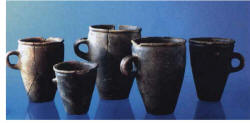 The local clays had been utilised for
millennia and pottery making was well-established. Local
manufacturing sites at Bestwall, Redcliffe and Worgret were making
pottery (Black Burnished Ware) with millions of pots being
produced on an industrial scale and exported far and wide. These
pots are found all over the country as well as in northern France.
All local sites produce vast numbers of this type of pottery and
Bucknowle is no exception.
The local clays had been utilised for
millennia and pottery making was well-established. Local
manufacturing sites at Bestwall, Redcliffe and Worgret were making
pottery (Black Burnished Ware) with millions of pots being
produced on an industrial scale and exported far and wide. These
pots are found all over the country as well as in northern France.
All local sites produce vast numbers of this type of pottery and
Bucknowle is no exception.
Our information Leaflet
Click to view jpeg images
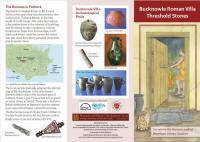
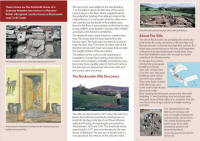
To view information the leaflet as PDF file please
click here

